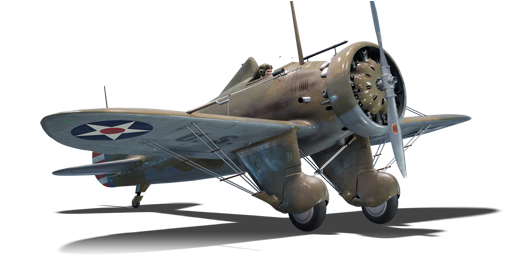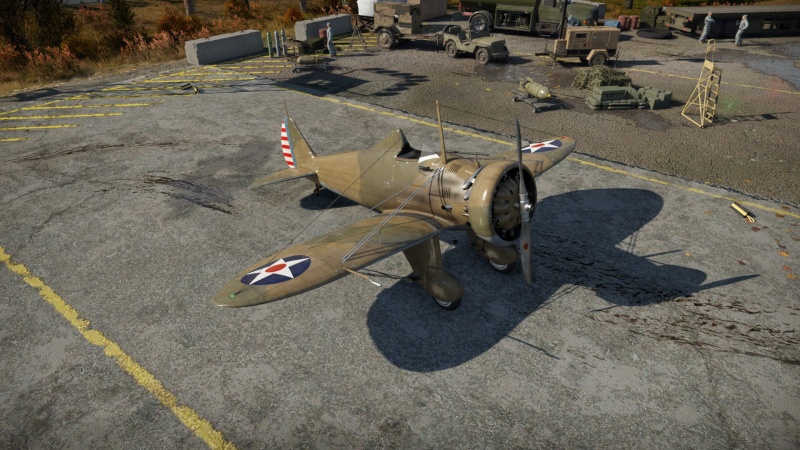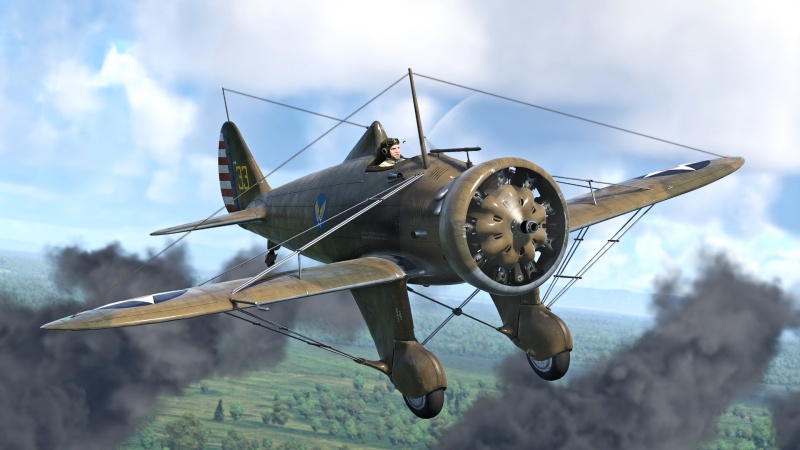P-26B-35
| This page is about the American fighter P-26B-35. For other versions, see P-26 (Family). |
Contents
Description
The P-26 was one of Boeing’s first monoplane aircraft and was quite advanced at its time. It was relatively fast thanks to its all-metal construction and the R-1340, a 9-cylinder radial engine that produced around ~550 HP. It was an extremely successful engine and was quickly innovated from originally making a measly 400 HP to almost 600 HP thanks to better fuels, forged engine parts, and improved cowlings. The P-26B was fitted with a fuel-injected version of the Wasp and landing flaps that greatly reduced the dangerous landing speed from 82 mph (131.2 km/h) to 73 mph (116.8 km/h).
Introduced since the start of the Open Beta Test before Update 1.27, the P-26B-35 Peashooter is a decent aircraft. It has an ok top speed of ~235 mph (377 km/h) which can outrun some bi-planes but many, relatively more modern monoplane aircraft are easily able to outrun and catch the P-26B. The P-26B is armed with 2 nose-mounted 7.62 mm machine guns and can drop two 100 lb bombs. It can also turn decently well however bi-planes are far superior in this department. Although the P-26B-35 Peashooter is a very old aircraft, it’s quite capable against relatively newer machines.
The P-26B-35 is a reserve fighter for the American aviation tree. The difference between the P-26A and P-26B variants is negligible (the B variant received a fuel-injector engine).
General info
Flight performance
| Characteristics | Max Speed (km/h at 2,286 m) |
Max altitude (metres) |
Turn time (seconds) |
Rate of climb (metres/second) |
Take-off run (metres) | |||
|---|---|---|---|---|---|---|---|---|
| AB | RB | AB | RB | AB | RB | |||
| Stock | 369 | 355 | 8500 | 18.6 | 19.7 | 9.3 | 170 | |
| Upgraded | 385 | 377 | 17.6 | 18.0 | 16.1 | 12.0 | ||
Details
| Features | ||||
|---|---|---|---|---|
| Combat flaps | Take-off flaps | Landing flaps | Air brakes | Arrestor gear |
| X | X | ✓ | X | X |
| Limits | ||||||
|---|---|---|---|---|---|---|
| Wings (km/h) | Gear (km/h) | Flaps (km/h) | Max Static G | |||
| Combat | Take-off | Landing | + | - | ||
| 508 | 508 | N/A | N/A | 240 | ~12 | ~8 |
| Optimal velocities (km/h) | |||
|---|---|---|---|
| Ailerons | Rudder | Elevators | Radiator |
| < 260 | < 180 | < 340 | > 190 |
| Compressor | Optimal altitude | 100% Engine power | WEP Engine power |
|---|---|---|---|
| Setting 1 | 1,829 m | 600 hp | N/A |
Survivability and armour
The P-26B has no armour protection and all important modules are centrally located, meaning that the aircraft is, much like most of its contemporaries, very fragile. However, this is mitigated somewhat by the scarcity of deadly large-calibre guns at the rank.
Modifications and economy
Armaments
Offensive armament
The P-26B-35 is armed with:
- 2 x 7.62 mm Browning machine guns, nose-mounted (500 rpg = 1,000 total)
Suspended armament
The P-26B-35 can be outfitted with the following ordnance:
- Without load
- 2 x 100 lb AN-M30A1 bombs (200 lb total)
Usage in battles
Like most US fighters, the P-26B-35 Peashooter is a decent Energy fighter even though its high lift creates unstable diving characteristics. Despite being a monoplane, the P-26 is not the fastest reserve fighter. In most regards the P-26B will be outmatched by enemy fighters; for example, the Japanese Ki-10s will not only turn circles around the P-26B, but will out-climb it and out-run it too. However, the slow German He 51 makes an easy target for a P-26B.
Unlike the P-26A-34 M2, the P-26B-35 does not have a 12.7 mm M2 Browning heavy machine gun. Both fighters are available at the same time and identical in all other regards.
Manual Engine Control
| MEC elements | ||||||
|---|---|---|---|---|---|---|
| Mixer | Pitch | Radiator | Supercharger | Turbocharger | ||
| Oil | Water | Type | ||||
| Not controllable | Not controllable Not auto controlled |
Not controllable Not auto controlled |
Not controllable Not auto controlled |
Separate | Not controllable 1 gear |
Not controllable |
Pros and cons
Pros:
- Fairly fast for a reserve
- Stable turning
Cons:
- Slower than some late biplanes
- No armour
- Poor dive characteristics
- Poor energy retention
History
The Boeing P-26 Peashooter was a plane both ahead of its time and quickly made obsolete. First flown in 1932, the P-26 is the oldest plane in the game. It was one of the first all-metal monoplanes adopted into military service in 1933 (in comparison, the He 51 and Ki-10 entered service in 1935), making it one of the fastest fighters in the world at the time, but it suffered from poor flight performance and dangerous landing characteristics. However, as newer fighters entered service around the world, the P-26s advantages diminished and its disadvantages became vulnerabilities. By the time of World War Two, the P-26 was hopelessly obsolete.
The P-26 saw the most of its combat serving in the Chinese Nationalist Air Force during the Second Sino-Japanese War, against Japanese Ki-10s, and notably A5Ms in some of the first all-metal monoplane dogfights. Although it performed admirably in the pursuit role (bomber interception), in air-to-air combat with Japanese fighters, the deficiencies of the model showed.
In US service, the P-26 had a similar record. During the Japanese invasion of the Philippines, the P-26s scored only a handful of air-to-air kills against Japanese attackers. On December 24, 1941, their crews burnt the remaining planes to prevent their capture. Of the one hundred and fifty-one built, only nine airworthy P-26s remained by Christmas 1941, a single squadron defending the Panama Canal Zone, which was removed from service shortly after.
| Archive of the in-game description | |
|---|---|
|
In addition to the P-26As they had already received, the USAAC ordered 25 more fighters. Two of them were designated P-26B (Model 266A). These aircraft were equipped with 600 hp Pratt & Whitney R-1340-33 nine-cylinder, air-cooled, fuel-injected engines. At first, landing flaps were mounted on the aircraft. Externally, these machines differed from the Р-26A in the absence of a carburettor air scoop and in the modified design of their exhaust pipes and the tail wheel. But in other respects, P-26B fighters were identical to the late variants of the P-26A. Both planes were test-flown in June 1935 and then handed over to the USAAC. It was planned that all 25 aircraft would be built as P-26Bs, but Pratt & Whitney Company was not able to supply R-1340-33 fuel-injected engines. So, 23 machines of the P-26C variant were produced and equipped with Pratt & Whitney R-1340-27 engines, with minor modifications to the fuel system and the carburettor. The first P-26Cs were delivered to the troops in early 1936. After a year in service, the P-26C planes were equipped with R-1340-33 fuel-injected engines and brought up to the P-26B's standard. They then obtained the update designation. The P-26 became the first monoplane – and the first all-metal fighter – accepted for service with the USAAC. At the same time, it was the last American fighter with external wing braces, an open cockpit and a non-retractable landing gear system. The Peashooter became the last fighter built on a full-scale basis by Boeing Company. The P-26 was not in service with the USAAC for very long. After the new P-35 and P-36 fighters were accepted into service, P-26 aircraft were withdrawn from the front lines. At the beginning of the Pacific War, P-26 fighters remained at US military bases on the Hawaiian Islands and in the area around the Panama Canal. 12 planes were handed over to the Philippine Air Force, which was in the process of forming. It was these aircraft that participated in combat operations in December 1941, and they were completely destroyed by the Japanese. The P-26 was officially withdrawn from service in early 1942. | |
Media
- Skins
See also
- Related development
- Aircraft of comparable role, configuration and era
External links
| Boeing Aircraft | |
|---|---|
| Aircraft | |
| Fighters | P-26A-33 · P-26A-34 M2 · P-26B-35 |
| Bombers | B-17E · B-17E/L · B-17G-60-VE |
| B-29A-BN | |
| Export | P-26A-34 · B-17G |
| Captured | ▅B-17E |
| Helicopters | |
| Attack | AH-64A · AH-64D |
| Export / Licensed | AH-64A (GR) · ▃AH-64A Peten · AH-64A Peten · ▅AH-64DJP · ▄AH Mk.1 · AHS |
| See Also | Tupolev Design Bureau · Westland Helicopters · Fuji Heavy Industries |
| For Boeing-built ships, see Boeing Marine Branch | |
| USA fighters | |
|---|---|
| P-26 Peashooter | P-26A-33 · P-26A-34 · P-26A-34 M2 · P-26B-35 |
| P-36 Hawk | P-36A · Rasmussen's P-36A · P-36C · ○P-36C · P-36G |
| P-39 Airacobra | P-400 · P-39N-0 · P-39Q-5 |
| P-40 | P-40C · P-40E-1 · P-40E-1 TD · P-40F-10 |
| P-43 Lancer | P-43A-1 |
| P-47 Thunderbolt | P-47D-22-RE · P-47D-25 · P-47D-28 · P-47M-1-RE · ⋠P-47M-1-RE · P-47N-15 |
| P-51 Mustang | P-51 · P-51A (Thunder League) · P-51C-10 · P-51D-5 · P-51D-10 · P-51D-20-NA · P-51D-30 · P-51H-5-NA |
| P-63 Kingcobra | P-63A-5 · P-63A-10 · P-63C-5 · ␠Kingcobra |
| Prototypes | XP-55 |
| F2A Buffalo | F2A-1 · Thach's F2A-1 · F2A-3 |
| BF2C | BF2C-1 |
| F3F | F3F-2 · Galer's F3F-2 |
| F4F Wildcat | F4F-3 · F4F-4 |
| F4U Corsair | F4U-1A · F4U-1A (USMC) · F4U-1D · F4U-1C · F4U-4 · F4U-4B · F4U-4B VMF-214 · F2G-1 |
| F6F Hellcat | F6F-5 · F6F-5N |
| F8F Bearcat | F8F-1 · F8F-1B |
| Other countries | ▃Ki-43-II · ▃Ki-61-Ib · ▃A6M2 · ▃Bf 109 F-4 · ▃Fw 190 A-8 · ▃Spitfire LF Mk IXc |






